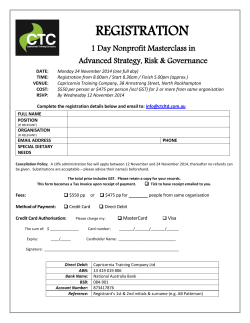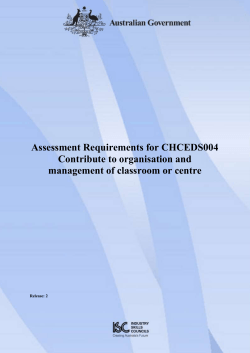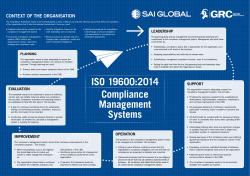
Mastering Metrics June 2015
CIM Level 6 Diploma in Professional Marketing Mastering Metrics (2201) June 2015 Assignment The assignment comprises THREE compulsory tasks Task 1 is worth 20 marks Task 2 is worth 35 marks Task 3 is worth 35 marks 10 marks are available for format and communication of information Total marks available – 100 Candidate guidance Answer all tasks The available marks are shown alongside each part of the task 10 marks are available for overall format and communication of information Read all tasks carefully before attempting them © The Chartered Institute of Marketing 2015 Mastering Metrics (2201) – June 2015 Scenario: Evaluating the Potential of Future Technology Investments to Support Marketing An important aspect of making a marketing investment is evaluating the success of the investment, with marketing metrics offering valuable insights in doing so. A range of metrics can be used by marketers to consider and evaluate investment effectiveness. As part of your role as a marketing analyst for your chosen organisation, you have been asked to compile a report evaluating the potential of a possible future investment, to be made within the next 12 months, in a type of technology to support marketing. You are asked to apply a range of relevant marketing metrics to evaluate the impact of this investment. You should select an organisation where you will have access to relevant statistics and financial data that will enable marketing metrics to be applied. With reference to this organisation, you should be able to present its current use of data, particularly in relation to making marketing and wider business decisions. Therefore, it is important that you are able to: collect appropriate data identify which data is used to make appropriate marketing decisions explain how it is used demonstrate the impact of marketing metrics on marketing and wider business decisions. Guidance notes: This assignment is made up of three tasks which should flow as a single document. There are TEN marks available for continuity of tasks, appropriate language and format used. This is awarded under ‘Format and communication of information’. The purpose of this assignment is to equip you with the ability to selectively analyse different sets of marketing data for insight, and to undertake effective decision making in relation to the utilisation of marketing resources. You have been asked to select an organisation which will be faced with the real or imagined scenario of a planned future investment in technology to support marketing. Your advice is needed on decisions in this area, and to present appropriate advice you should utilise a wide range of marketing metrics to analyse a selection of data gathered. You should acknowledge all sources/methodologies/applications using the Harvard referencing system. Maximum page count: 16 pages Page 2 of 8 Mastering Metrics (2201) – June 2015 TASK 1 Assessment criteria covered in Task 1: AC1.1, AC1.2, AC1.3, AC1.4, AC2.1, AC5.1, AC5.3 Please refer to the module specification for assessment criteria details. In this first section of your report, you should discuss how technology and metrics are currently used to support marketing in your chosen organisation. Required: (a) Using the organisation summary guidelines, provide a background to your chosen organisation. This section should be placed at the end of your report. (b) Identify and explain the role of marketing metrics in the context of marketing and the process of making marketing decisions in your chosen organisation. You should refer to relevant theory within this subtask. (c) (5 marks) (5 marks) Identify any key types of technology currently being used to support marketing activities in your chosen organisation. Evaluate how effectively this technology currently supports the marketing function of the organisation. (5 marks) (d) Explain how effectively marketing metrics are currently utilised in your chosen organisation. (5 marks) (Total – 20 marks) (Maximum page count – 4 pages) (1 page of the total 4 pages for this task should be used for the organisation summary) Page 3 of 8 Mastering Metrics (2201) – June 2015 TASK 2 Assessment criteria covered in Task 2: AC1.2, AC1.4, AC2.1, AC2.2, AC2.3, AC3.1, AC3.2, AC3.3, AC4.1, AC4.2, AC5.3, AC6.2 Please refer to the module specification for assessment criteria details. This part of your report centres on marketing performance in relation to a potential new investment in technology to support marketing, using a review of data relating to your chosen organisation’s marketing function. In addition, the use of a marketing dashboard will enable a diagnosis of current business strength, and will assist in making strategic decisions. Required: (a) Evaluate the impact of current technology supporting the marketing decision-making of the chosen organisation, through analysis of relevant data relating to marketing activity. Determine the areas of the marketing function which would benefit most from potential new investment in technology, with reasons. (b) Identify and discuss a potential new technology investment which would enhance the effectiveness of your chosen organisation’s marketing function. Using marketing metrics, prepare an appraisal of the proposed marketing technology investment, including consideration of the return on investment. (c) Prepare a dashboard of the marketing metric tools used, showing a visual/graphical/numerical comparison of the main metrics which will help the chosen organisation evaluate the proposed marketing technology investment. (d) Reflect on the quality of data available to evaluate the new technology investment. Analyse the effectiveness of this data in supporting the investment decisions to be made. (10 marks) (10 marks) (8 marks) (7 marks) (Total – 35 marks) (Maximum page count – 6 pages) Page 4 of 8 Mastering Metrics (2201) – June 2015 TASK 3 Assessment criteria covered in Task 3: AC4.1, AC5.1, AC5.2, AC5.3, AC6.1, AC6.2, AC6.3 Please refer to the module specification for assessment criteria details. You should now reflect on the value of technology to support marketing, by preparing a briefing paper for your chosen organisation. This briefing paper should evaluate TWO further potential technology investments which could support the chosen organisation’s marketing function. Your briefing paper should include consideration of how any further new technology investments to support marketing activities could be measured and monitored in the future. Required: (a) Identify TWO different potential technology investments which could support the chosen organisation’s marketing function. Evaluate the application of each of these in terms of their relevance for your chosen organisation. (b) Identify the benefits and limitations of each of the TWO different potential technology investments, together with a recommendation as to their future use within your chosen organisation. (c) Recommend a series of appropriate metrics to measure and monitor the effectiveness of the TWO new technology investments by your chosen organisation’s marketing function. This should include recommendations as to who in the chosen organisation should take responsibility for measuring and monitoring marketing technology effectiveness in the future. (13 marks) (13 marks) (9 marks) (Total – 35 marks) (Maximum page count – 6 pages) Page 5 of 8 Mastering Metrics (2201) – June 2015 TASK 1 – REPORT FORMAT TASK 1 MAXIMUM page count: 4 pages Within Task 1 candidates should be able to identify a range of different metrics relating to marketing, and link these to decisions made within the chosen organisation. In addition, the candidate should consider the use of technology which supports marketing activities and the wider marketing function. Guidance notes: Specific application to the candidate’s chosen organisation is essential. In Task 1 candidates should consider how technology is used to support marketing decisions within the chosen organisation, together with the current use and application of marketing metrics to support the marketing function. TASK 2 – REPORT FORMAT TASK 2 MAXIMUM page count: 6 pages The purpose of this task is to equip the candidate with the ability to selectively analyse different sets of marketing data for insight, and to undertake effective decision making in relation to the utilisation of marketing resources, particularly in terms of investment in technology to support marketing. Guidance notes: In order to present a clear picture of these metrics, marketing has developed the approach of dashboarding. This uses a selection of the most relevant marketing metrics aiding an evaluation of the technology investment, all represented at the same time, thus providing a comparison. Candidates will need to utilise the data relating to the use of technology to support marketing which they were recommended to collect previously. This data should be analysed within this task. The analysis should offer the opportunity to select those metrics which will support the best advice on the potential investment in technology. Page 6 of 8 Mastering Metrics (2201) – June 2015 TASK 3 – BRIEFING PAPER FORMAT TASK 3 MAXIMUM page count: 6 pages The final section relates to further potential investments in technology to support marketing within the chosen organisation. In addition, the application of these additional technology investments is to be considered and presented in the format of a briefing paper. Guidance notes: The candidate should consider how any implementation of the proposed technology in the chosen organisation could be monitored using relevant metrics and staff resources. Typical future technology investments to support the marketing function could include, for example, real-time data analysis tools, social media analytics tools, plus a wide range of other technologybased investments. Page 7 of 8 Mastering Metrics (2201) – June 2015 Organisation summary To be included at the end of the report. Contents will contribute to the FIVE marks available in Part (a) of Task 1. The following headings should be included: Organisation name Type of organisation, for example, profit or not-for-profit, local, national, global, and type of legal entity Size of organisation in terms of turnover and number of employees Range of products and services provided Customer base, for example, B2B/B2C Competitors Cross-functional relationships within the organisation Other important stakeholders Other relevant information Page 8 of 8
© Copyright 2025









